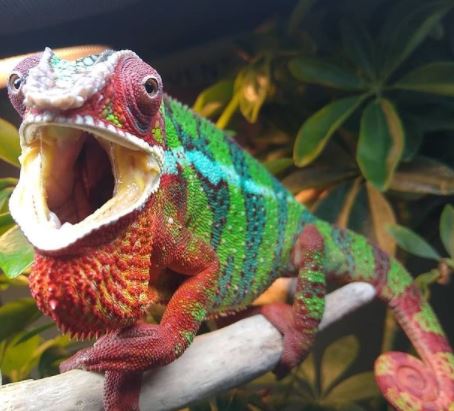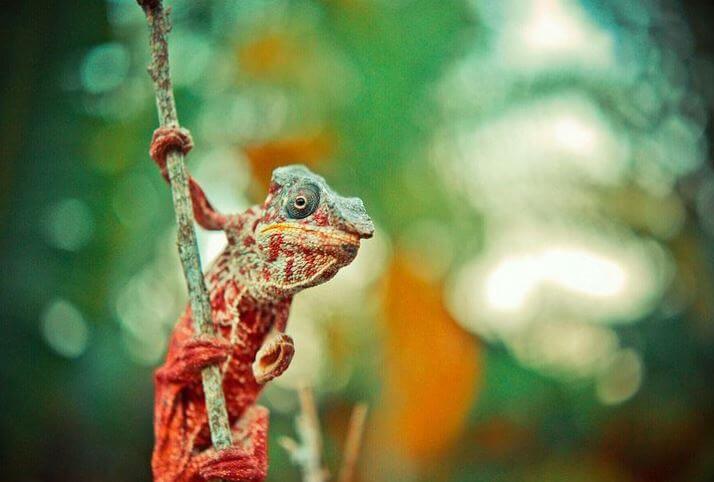How to keep a chameleon cage warm? A chameleon’s cage should be kept at a temperature of about eighty degrees Fahrenheit.
If the room is too cold, there are some tricks to help keep the cage warm.
One way is by using an incandescent bulb as a heat source.
An incandescent bulb will generate heat from both ends and produce light from one end.
The other way is to purchase a red or infrared light bulb for nighttime use only because these wavelengths do not disrupt insect activity, yet they emit enough warmth to keep the chameleon comfortable during its sleep cycle.
Related Posts:
- Top 8 Best Misting Systems for Chameleons
- Bearded Dragon vs. Chameleon: Facts and Differences
- How to Clean the Bottom of a Chameleon Cage?
- What Plants to Put in Chameleon Cage?
- How to Decorate a Chameleon Cage?
How to Keep a Chameleon Cage Warm?
So, how to keep a chameleon cage warm? Almost all chameleon keepers know the importance of thermal regulation when keeping their reptiles.
The most common mistake that many new owners make is providing too little warmth for the animals, either with too low wattage in the vivarium or by using heating equipment that provides poor measures of power (such as ceramic heat emitters).
The majority of chameleons do well with ambient temperatures in the 28 to 33°C degree range. Some species may require cooler or warmer temperatures, but these numbers are generally accepted in good husbandry practice.
How to achieve this is often misunderstood, though, and it’s difficult to find correct information on how to keep a chameleon cage warm at home.

Not everyone has access to an infrared thermometer or infrared temperature guns, and most heating equipment does not provide accurate measures of the measured temperature
To make matters more confusing, many chameleon keepers around the world use an old-fashioned method for measuring heat that is based on a faulty understanding of reptile physiology.
The assumption that heat emitters or heat lamps produce a certain amount of heat is wrong, and measuring temperatures with a digital thermometer in the basking area is flawed as well.
It’s important to understand some basics about thermoregulation in reptiles, not only because it leads to better husbandry practices but also because it helps owners avoid critical mistakes, which could lead to sick or dead animals.
This article will explain why these methods are problematic and how they can be replaced by better and more reliable protocols.

Can Digital Thermometers Measure the Temperature of Basking Spots Accurately?
Most people probably use a regular mercury/mercury-free digital kitchen or clinical thermometer to check how hot it is at their chameleon’s basking spot.
This is certainly better than using no monitoring equipment, but such thermometers are not accurate enough for this purpose!
A regular clinical (mercury) thermometer that most reptile owners use would show very different results depending on where you measure and with what contact method you’re taking your temperature.
These devices are only accurate to about +/- 0.3 degrees Celsius when in contact with the body or in a small container/vivarium where the heat dissipates rapidly.
A temperature that seems in the 28° to 32° degree range (“perfect” for many species) could be way too hot for other animals, whereas another animal could get burned by 33°C+ temperatures!
Unfortunately, this does happen all too often.
A digital infrared thermometer is much more precise but still has its limitations, which are not mentioned anywhere on their packaging (most of them have no information whatsoever about accuracy).
The ones that measure surface temperature only show an inaccurate approximation of how hot something really is because they can’t account for air circulation and other factors, and the ones that claim to be able to measure temperature through glass or plastic have a slight error margin, too.
These readings are more reliable when taking the temperature of a smaller, enclosed space or with a very thin material between you and your reptile, but it’s still not perfect.
Why Shouldn’t You Measure Basking Spot Temperatures With Infrared Thermometers?
To monitor thermal gradients in vivariums, some chameleon keepers use simple digital infrared thermometers which they ‘point’ at various parts of the vivarium from a distance.
This is better than measuring surface temperatures only, I suppose, but there are several problems with this method as well.
By standing in one place and pointing an infrared thermometer at an object, it’s impossible to get reliable temperature values when the basking spot you’re measuring is in motion (for example, when your chameleon retreats/moves forward to bask/shade).
For this reason, such measurements may be useful as a rough guideline or check that temperatures are within safe ranges, but they do not give accurate enough data to use as a tool for measuring true basking spot temperatures.
How to Measure Basking Spot Temperatures?
Since infrared thermometers and digital thermometers can’t be used reliably, we should look for another method to monitor heat gradients accurately.
Fortunately, we don’t need anything except our eyes and common sense.
To ensure that we don’t cause thermal burns to our animals, we should instead rely on following these simple guidelines:
- Make sure your chameleon has a gradient of temperatures to choose from (ideally 32° to 34°C at the basking zone and 25° to 28°C in the cooler zone). This can be done by pointing a thermometer at various parts of the vivarium when it’s in motion, or by getting infrared temperature readings with an infrared thermometer. You’ll find some cheap digital infrared meters for around $50, which are better than nothing if you’re not sure what’s going on inside your vivarium. I recommend taking several measurements at many different points in the day because each spot will give a different reading depending on the time of day, air circulation/time since it was last misted, etc.
- Make sure full-spectrum lighting reaches all parts of your vivarium at ground level. This can easily be arranged by having something like live plants, branches, or logs that touch the floor in various places where heat lamps are installed, or by simply misting around these objects every other day.
- Make sure your chameleon has access to direct/indirect sunlight when you’re out for most of the year (either keep him outside or provide an incandescent basking lamp if he’s kept indoors — do not rely on heating equipment alone). Exceptions would apply during winter months or when keeping tropical species outside in colder climates, in which case supplementary heating may be required to ensure that all parts of the vivarium are within safe thermal ranges.
- Make sure you have a good thermometer with at least 0.5°C accuracy installed inside your vivarium so you can check if temperatures are within acceptable limits when necessary. Using more than one thermometer is useful too because they will give slightly different readings when there’s air movement or when it’s dark/light.

What Is the Benefit of Sunlight for Chameleons?
Early in the morning, they usually bask on tree branches to absorb sunlight.
This boosts the metabolism and enables them to digest their food more easily throughout the day.
Chameleon’s body color, behavior, and social interaction are regulated by temperature combined with light intensity. Chameleons are ectothermic (cold-blooded), so basking in the sun allows them to fully function by raising their body temperature.
A chameleon can actually warm its blood 10 degrees Fahrenheit after basking for about half an hour!
This also regulates their appetite. They eat more when it is sunny than on dull days because digestion is easier at higher temperatures. If it is overcast or raining, chameleons will not bask but stay at home or in their shelters.
Cold-blooded animals like reptiles and amphibians in cold climates burrow underground in the winter to survive.
The chameleon’s coloration also changes when it gets cold with their skin usually getting darker when the temperature drops low. Chameleons will hide for days after a snowfall before venturing out again.
Chameleons drink water by sitting in rain-filled cavities such as tree hollows, or they wait for the early morning dew on leaves and flowers, which they lap up using their tongues that can flick at 100 per second!
They sometimes drink from puddles and droplets of water on leaves and branches, too, but this mostly happens during rainy seasons where they can get enough rainfall.
However, long-term effects could result in permanent damage to their eyes.

What Is the Perfect Time to Turn On Basking Bulbs?
It should be set up to come on about 30 minutes before you get up in the morning so the tank is warm when you get up.
The basking spot lamp can be turned on for 30 minutes or an hour after the basking bulb turns off, then both can turn completely off. This will give your chameleon a chance to heat back up again before lights are completely off for nighttime.
Chameleon’s eyes can become irritated if they are left directly under the light because the ultraviolet light also comes down towards them. However, don’t put it too far away either or they won’t benefit from the UV rays.
Chameleons need 6 to 12 inches between their face and any source of UVA/UVB since this emits small amounts of UVA/UVB that the chameleon can absorb.
Conclusion
When it comes to keeping a chameleon cage warm, you have three options. You can use either an infrared heating panel or a ceramic heater inside the enclosure for short-term relief from cold temperatures.
Or, if your climate is more extreme and requires year-round warmth, then investing in an outdoor heated chameleon enclosure may be necessary.
The last option would be using under-tank heat pads that are safe for reptiles as long as they’re not left on too high of a setting.
Key points on how to keep a chameleon warm at night:
1. Ensuring Nighttime Temperature:
- Heat Sources: Use ceramic heat emitters (CHE) or nocturnal reptile heat bulbs, as these emit heat without light, mimicking the natural drop in temperature at night.
- Heating Elements: Place the heat source on one side of the enclosure to create a thermal gradient, allowing the chameleon to move between warmer and cooler areas.
2. Maintaining Ambient Temperature:
- Insulation: Ensure the enclosure is adequately insulated, preventing heat loss. Styrofoam panels or insulating materials can help maintain stable temperatures.
- Enclosure Size: Smaller enclosures can retain heat better than larger ones. Consider using appropriately sized enclosures for your chameleon to maintain a more consistent temperature.
3. Monitoring and Adjusting:
- Thermometers: Use digital thermometers to monitor the temperature in different parts of the enclosure. Aim for a nighttime temperature drop, typically around 65-70°F (18-21°C).
- Thermostats: Employ thermostats to regulate the heat source, ensuring it doesn’t get too hot or too cold during the night. This maintains a stable environment for your chameleon.
4. Supplementary Measures:
- Heating Pads: Under-tank heating pads or heat mats placed on the enclosure’s side can offer additional warmth if needed. However, ensure they don’t become the primary heat source.
- Blankets or Covers: Covering the enclosure partially with a blanket or towel can help retain warmth. Ensure proper ventilation to prevent overheating.
5. Nighttime Behavioral Considerations:
- Observation: Chameleons are nocturnal, and their behavior might change at night. Ensure they have enough darkness for rest and reduce disturbances during their active period.
- Hydration: Even at night, access to water is essential. Mist the enclosure before nighttime to maintain humidity and provide drinking opportunities.
6. Regular Checks and Adjustments:
- Consistent Monitoring: Regularly check temperatures to ensure they remain within the optimal range for your chameleon’s species.
- Adjustments: Be prepared to make adjustments based on your chameleon’s behavior and environmental conditions. Regularly review and adapt the heating setup if needed.
Keeping your chameleon warm at night is crucial for their wellbeing. By employing suitable heating sources, monitoring temperatures, and making necessary adjustments, you can create a comfortable and healthy nighttime environment for your pet chameleon. Always consider their species-specific requirements when providing nighttime heating
Further Reading:
- 7 Best Lighting for Chameleons: What Is the Best Bulb?
- 7 Best Plants for Turtle Tank: Buying Guide
- How to Raise Humidity in Chameleon Cage?
- 7 Best Substrate for Chameleons


